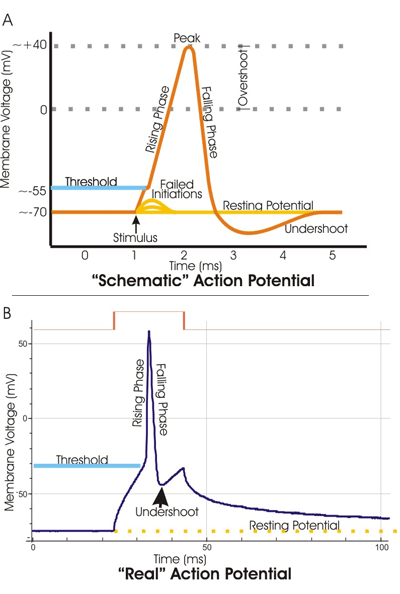


Describe the changes that occur to the membrane that result in the action potential.Describe the components of the membrane that establish the resting membrane potential.Nodes of Ranvier also save energy for the neuron since the channels only need to be present at the nodes and not along the entire axon. If nodes of Ranvier were not present along an axon, the action potential would propagate very slowly since Na + and K + channels would have to continuously regenerate action potentials at every point along the axon instead of at specific points.

This ‘jumping’ of the action potential from one node to the next is called saltatory conduction. Flow of ions through these channels, particularly the Na + channels, regenerates the action potential over and over again along the axon. These unmyelinated spaces are about one micrometer long and contain voltage gated Na + and K + channels. The nodes of Ranvier, illustrated in Figure 3 are gaps in the myelin sheath along the axon. Action potentials travel down the axon by jumping from one node to the next. Nodes contain voltage-gated K + and Na + channels. Eventually the extra K + ions diffuse out of the cell through the potassium leakage channels, bringing the cell from its hyperpolarized state, back to its resting membrane potential.įigure 3. Nodes of Ranvier are gaps in myelin coverage along axons. At this point, the sodium channels will return to their resting state, meaning they are ready to open again if the membrane potential again exceeds the threshold potential. The diffusion of K + out of the cell actually hyperpolarizes the cell, in that the membrane potential becomes more negative than the cell’s normal resting potential. As K + ions leave the cell, the membrane potential once again becomes negative. At the same time, voltage-gated K + channels open, allowing K + to leave the cell. This begins the neuron’s refractory period, in which it cannot produce another action potential because its sodium channels will not open. To accomplish this, the Na +channels close and cannot be opened. Once depolarization is complete, the cell must now “reset” its membrane voltage back to the resting potential. Action potentials are considered an “all-or nothing” event, in that, once the threshold potential is reached, the neuron always completely depolarizes. Once the sodium channels open, the neuron completely depolarizes to a membrane potential of about +40 mV. Na + channels in the axon hillock open, allowing positive ions to enter the cell (Figure 1). A stimulus from a sensory cell or another neuron depolarizes the target neuron to its threshold potential (−55 mV). At excitatory synapses, this opening allows positive ions to enter the neuron and results in depolarization of the membrane-a decrease in the difference in voltage between the inside and outside of the neuron. When neurotransmitter molecules bind to receptors located on a neuron’s dendrites, ion channels open. Transmission of a signal within a neuron (from dendrite to axon terminal) is carried by a brief reversal of the resting membrane potential called an action potential. Transmission of a signal between neurons is generally carried by a chemical called a neurotransmitter. Explain the stages of an action potential and how action potentials are propagatedĪ neuron can receive input from other neurons and, if this input is strong enough, send the signal to downstream neurons.


 0 kommentar(er)
0 kommentar(er)
